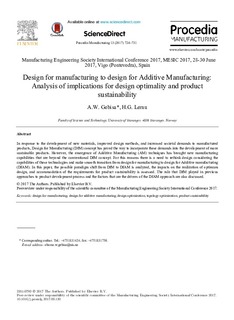| dc.contributor.author | Gebisa, Aboma Wagari | |
| dc.contributor.author | Lemu, Hirpa G. | |
| dc.date.accessioned | 2018-05-23T09:23:54Z | |
| dc.date.available | 2018-05-23T09:23:54Z | |
| dc.date.created | 2017-10-12T09:13:04Z | |
| dc.date.issued | 2017-10 | |
| dc.identifier.citation | Gebisa, A.W., Lemu, H.G., (2017) Design for manufacturing to design for Additive Manufacturing: Analysis of implications for design optimality and product sustainability. Procedia Manufacturing. 13,pp. 724-731. | nb_NO |
| dc.identifier.issn | 2351-9789 | |
| dc.identifier.uri | http://hdl.handle.net/11250/2498836 | |
| dc.description.abstract | In response to the development of new materials, improved design methods, and increased societal demands to manufactured products, Design for Manufacturing (DfM) concept has paved the way to incorporate these demands into the development of more sustainable products. However, the emergence of Additive Manufacturing (AM) techniques has brought new manufacturing capabilities that are beyond the conventional DfM concept. For this reasons there is a need to rethink design considering the capabilities of these technologies and make smooth transition from design for manufacturing to design for Additive manufacturing (DfAM). In this paper, the possible paradigm shift from DfM to DfAM is analyzed, the impacts on the realization of optimum design, and accommodation of the requirements for product sustainability is assessed. The role that DfM played in previous approaches to product development process and the factors that are the drivers of the DfAM approach are also discussed. | nb_NO |
| dc.language.iso | eng | nb_NO |
| dc.publisher | Elsevier | nb_NO |
| dc.rights | Attribution-NonCommercial-NoDerivatives 4.0 Internasjonal | * |
| dc.rights.uri | http://creativecommons.org/licenses/by-nc-nd/4.0/deed.no | * |
| dc.subject | design for manufacturing | nb_NO |
| dc.subject | design for additive manufacturing | nb_NO |
| dc.subject | design optimization | nb_NO |
| dc.subject | topology optimization | nb_NO |
| dc.subject | product sustainability | nb_NO |
| dc.title | Design for manufacturing to design for Additive Manufacturing: Analysis of implications for design optimality and product sustainability | nb_NO |
| dc.type | Journal article | nb_NO |
| dc.type | Peer reviewed | nb_NO |
| dc.description.version | publishedVersion | nb_NO |
| dc.rights.holder | © 2017 The Authors | nb_NO |
| dc.subject.nsi | VDP::Technology: 500::Materials science and engineering: 520 | nb_NO |
| dc.source.pagenumber | 724-731 | nb_NO |
| dc.source.volume | 13 | nb_NO |
| dc.source.journal | Procedia Manufacturing | nb_NO |
| dc.identifier.doi | 10.1016/j.promfg.2017.09.120 | |
| dc.identifier.cristin | 1504019 | |
| cristin.unitcode | 217,8,5,0 | |
| cristin.unitname | Institutt for maskin, bygg og materialteknologi | |
| cristin.ispublished | true | |
| cristin.fulltext | original | |
| cristin.qualitycode | 1 | |

